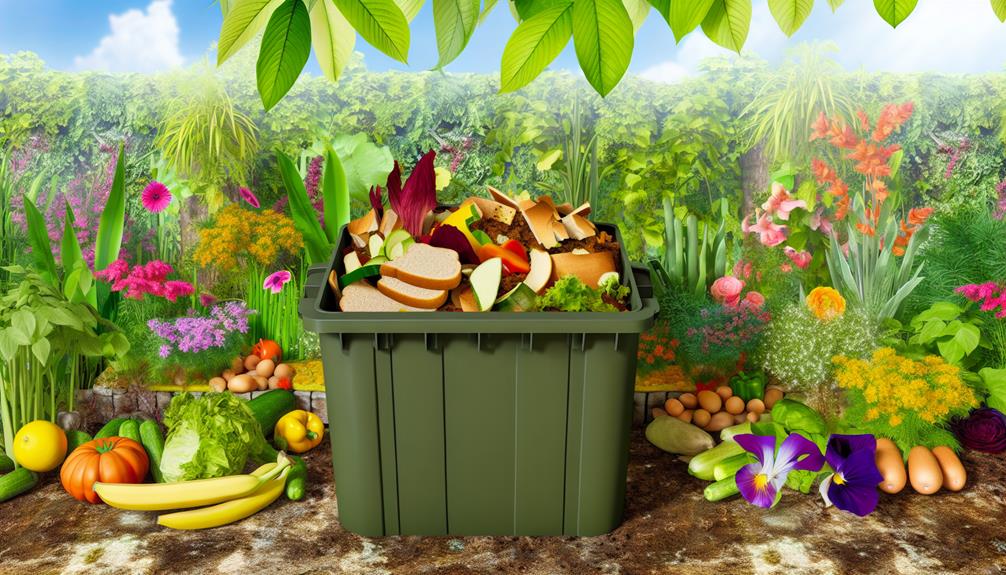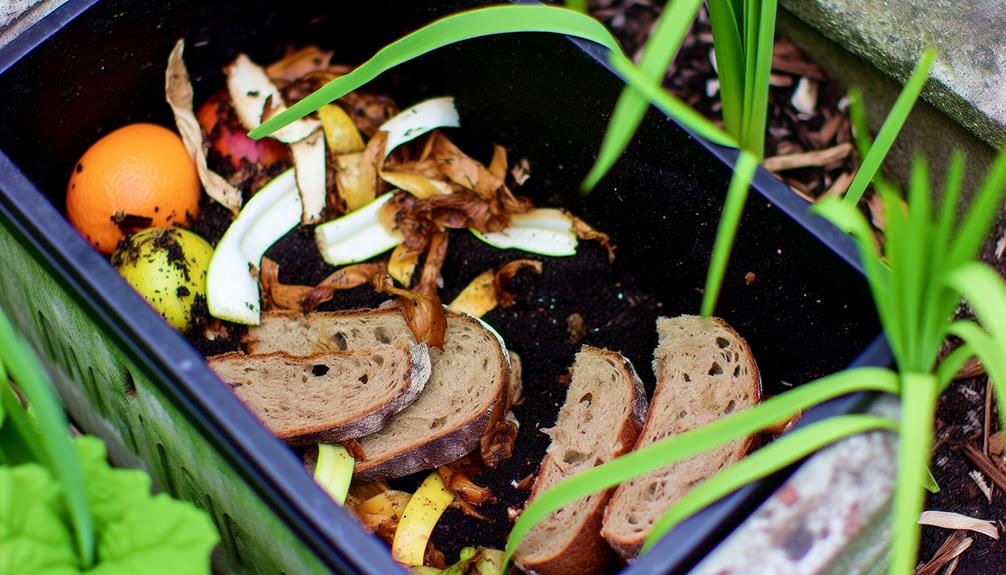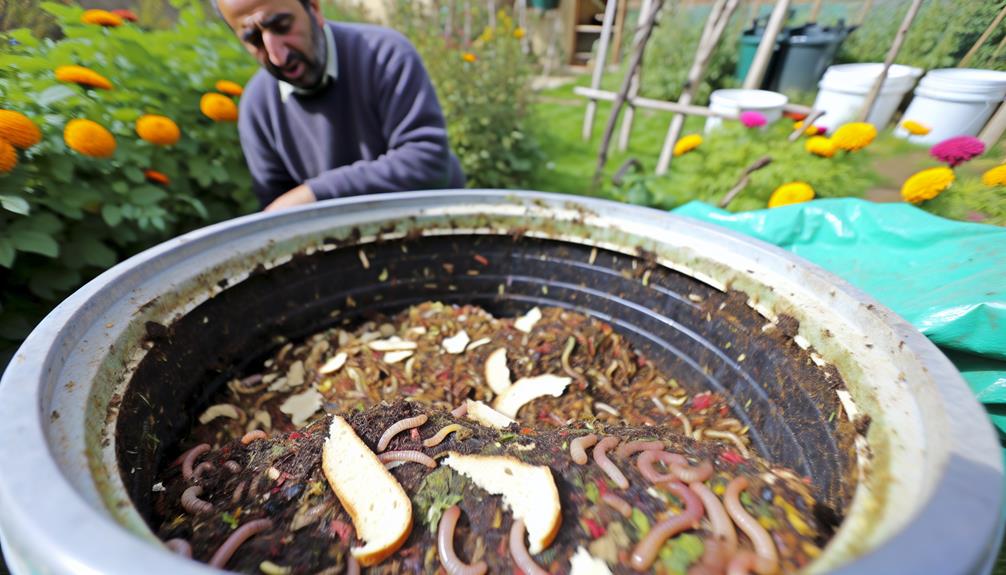

You can compost sourdough, which enhances your pile with beneficial microbes, moisture, and nutrients. First, break the sourdough into smaller pieces to speed up decomposition. To avoid attracting pests, bury the sourdough deeper in the pile. Make sure to balance it with carbon-rich browns and nitrogen-rich greens.
A good mix guarantees proper aeration and moisture, resembling a damp sponge. Regular turning of the pile helps with aeration and decomposition. Remember, fresh and mold-free sourdough is best to prevent introducing pathogens. Explore additional practical tips and strategies for a thriving compost pile next.
Adding bread to your compost pile can be a bit tricky, so it’s important to weigh the pros and cons before tossing in those leftover slices. On the plus side, bread has a short bread lifespan, meaning it breaks down quickly and adds valuable nutrients to your compost. This can help speed up the overall decomposition process, contributing to a richer compost.
However, there are some cons to take into account. One common composting myth is that bread is always a good addition to your pile. In reality, bread can attract pests like rodents and insects, which can disrupt your composting efforts. Additionally, moldy bread might introduce unwanted pathogens into your compost, potentially harming your garden plants later on.
To mitigate these issues, you can bury the bread deeper in the pile to minimize pest attraction. Also, tearing the bread into smaller pieces can help it break down more efficiently.
Always balance your compost by adding plenty of greens (like vegetable scraps) and browns (like leaves) to maintain a healthy compost environment.
Sourdough can enhance your compost pile by introducing beneficial microbes and organic matter. These microbes, produced during the fermentation process, can help break down other materials in your compost, speeding up decomposition and improving overall compost quality. The fermentation process in sourdough creates a rich environment of bacteria and yeast that can transfer to your compost pile, fostering a diverse microbial community.

The nutrient content of sourdough bread adds value to your compost. It’s rich in carbohydrates, which provide an energy source for decomposing organisms. These carbohydrates, along with proteins and fibers found in sourdough, break down into simpler compounds that nourish your compost pile. The result is a more nutrient-dense compost that can better support plant growth.
When you add sourdough to your compost, you’re also increasing its moisture content. This helps maintain the right balance of wet and dry materials, which is essential for efficient composting. Make sure you mix the sourdough well with other compost materials, like leaves and grass clippings, to avoid clumping and to distribute the nutrients evenly.
Also Read: Can You Compost Broad Beans?
To prepare sourdough for composting, start by breaking it into small pieces to speed up decomposition.
Make sure the bread is fresh and free of mold, as mold can disrupt the composting process.
Start by tearing the sourdough into smaller pieces to speed up the composting process. When you break the bread into chunks, you increase the surface area, which allows microorganisms to work more efficiently.
This step is important, especially if you’re worried about composting myths that suggest bread doesn’t break down well. By properly prepping your sourdough, you’re not only respecting its rich history but also contributing to a healthier compost pile.
Taking a moment to break your sourdough into pieces can be a mindful practice, connecting you with the cycle of life.
Here’s a quick breakdown to guide you:
| Step | Emotion |
|---|---|
| Tear into pieces | Satisfaction |
| Add to compost | Contribution |
| Mix well | Engagement |
| Watch it decompose | Curiosity |
| Use finished compost | Fulfillment |
While breaking your sourdough into pieces is beneficial, ensuring the bread isn’t moldy is equally important for a healthy compost. Mold prevention starts with proper bread storage. Always store your sourdough in a cool, dry place. Using a bread box or a paper bag can help control moisture levels, reducing the likelihood of mold growth.
If you notice any mold on your bread, it’s best to avoid adding it to your compost pile. Mold can spread quickly and may disrupt the balance of your compost, potentially harming beneficial microbes.
Before adding sourdough to your compost, inspect the bread closely. Any dark spots, fuzzy patches, or off smells are signs of mold, and such bread should be discarded rather than composted.
Incorporate your sourdough into your compost by mixing it with green materials like vegetable scraps and grass clippings to maintain a balanced nutrient mix. This balance is vital for effective composting, as it guarantees that your compost pile has the right combination of carbon and nitrogen.
Start by breaking down the sourdough into small pieces, making it easier to decompose. Mixing techniques are important here; layer the sourdough with green sources to distribute nutrients evenly. Aim for a ratio of roughly one part sourdough to three parts green materials. The greens provide the nitrogen needed to harmonize the carbon-rich bread.
For green sources, you can use kitchen scraps like fruit peels, coffee grounds, and vegetable remains. Yard waste such as grass clippings and fresh plant trimmings also works well.
Regularly turn the compost to enhance aeration and speed up the decomposition process. This method will prevent your compost from becoming too dense and help maintain the necessary moisture levels.
To balance your compost pile, you’ll need to maintain the right green to brown ratio, which guarantees proper decomposition.
Pay close attention to moisture levels and aeration to keep the pile active and healthy.
Achieving the right green to brown ratio is crucial for a healthy and efficient compost pile. This balance guarantees your compost nutrients are optimized and helps with waste reduction.
Greens are nitrogen-rich materials like fruit scraps and vegetable peels, while browns are carbon-rich items such as dried leaves and cardboard. To maintain the proper ratio, aim for about 2 parts green to 3 parts brown.
Here’s how you can do it:
After balancing your greens and browns, focus on maintaining the right moisture and aeration to keep your compost pile active and healthy.
Proper moisture levels are vital; aim for the consistency of a damp sponge. Too much water can lead to anaerobic conditions, causing foul odors and slowing decomposition. If your compost is too dry, it won’t break down efficiently. Regularly check the moisture by squeezing a handful of compost— if a few drops of water come out, it’s just right.
For aeration techniques, turning your compost pile is essential. Use a pitchfork or compost turner to mix the materials every few weeks. This action introduces oxygen, helping microorganisms thrive and speeding up the breakdown process. Make sure that the compost pile has enough structure to allow airflow; incorporating coarse materials like straw or small branches can help.
When composting sourdough, it’s essential to take steps that prevent pests and odors from becoming a problem. Effective pest deterrents and odor management are key to maintaining a healthy and welcoming compost pile. Here are three practical tips to help you achieve this:
Always cover your compost with a layer of brown materials like leaves or straw after adding sourdough. This helps mask the scent and deters pests such as rodents and insects from being attracted to the pile.
Enclosed compost bins with secure lids are great for keeping pests out. They also help control odors by containing the smell within the bin, making your composting experience more pleasant for you and your neighbors.
Incorporate materials like shredded newspaper, cardboard, or sawdust into your compost. These items act as odor absorbers and help balance the nitrogen-rich sourdough, reducing the chance of unpleasant smells.
Also Read: Can You Compost Celery?
To create the best environment for composting sourdough, make sure your compost pile has the right balance of moisture, aeration, and temperature. Moisture control is essential; your compost should feel like a damp sponge. Not too wet or too dry. Turn your pile regularly to provide oxygen, which helps microbes break down the sourdough and other materials.
Temperature control is vital for efficient composting. Aim to maintain your compost pile between 135°F and 160°F. This range encourages the activity of thermophilic bacteria, which speed up decomposition. Use a compost thermometer to monitor the temperature and adjust as needed.
Maintaining the pH balance is also key. Compost thrives in a slightly acidic to neutral pH range, around 6.0 to 7.5. You can test the pH using a simple soil pH test kit. If the pH is off, add lime to raise it or sulfur to lower it.
Here’s a quick guide to help you:
| Condition | Ideal Range | Tips |
|---|---|---|
| Moisture | Damp sponge feeling | Add water or dry materials |
| Aeration | Regular turning | Turn pile every few weeks |
| Temperature Control | 135°F – 160°F | Use a compost thermometer |
| pH Balance | 6.0 – 7.5 | Adjust with lime or sulfur |
Sourdough often finds new life beyond the compost pile through creative culinary and practical applications. Don’t throw away that extra sourdough starter just yet. Instead, consider these three alternative uses:
Also Read: Can You Compost Cat Feces?
Encountering issues with your sourdough starter or bread can be frustrating, but understanding common problems and their solutions can help you achieve the perfect loaf.

If your starter isn’t bubbling, it may need more frequent feedings or a warmer spot to thrive. Don’t worry—sometimes it just takes a little patience.
Should your bread turn out dense or flat, consider adjusting the hydration levels or proofing times. A common issue is under-proofing, which can be solved by allowing the dough more time to rise.
When dealing with excess sourdough discard, composting techniques come in handy. Sourdough discard can provide valuable nutrients to your compost pile. Just make sure to balance it with brown materials like leaves or cardboard to maintain proper waste management. Avoid adding too much at once to prevent any potential issues with acidity.
If mold appears on your starter, it’s best to discard it and start fresh. Mold can be harmful and indicates that the environment wasn’t ideal. Clean your containers thoroughly before beginning again.
Yes, sourdough can attract pests if added whole. For effective pest prevention and compost hygiene, break it into small pieces and mix it with other compost materials. This will help maintain a balanced, pest-free compost pile.
The decomposition rate of sourdough in compost depends on your composting conditions. With a balanced mix of greens and browns, good aeration, and moisture, sourdough can decompose within a few weeks to a couple of months.
Yes, you can compost sourdough with mold on it. Most mold types won’t harm your compost. For compost safety, make sure you mix it well and maintain a balanced compost pile. You’re contributing to a healthier planet!
Yes, you can compost sourdough starter discard. It adds nutrient content to your compost. Just make sure to balance moisture by mixing it with dry materials, so you maintain a healthy compost environment for everyone involved.
Yes, you should break the sourdough into smaller pieces before composting. This composting tip helps the bread’s texture decompose faster, ensuring it integrates smoothly into your compost and supports a thriving community of microorganisms.
To effectively compost sourdough, remember to break it into small pieces and mix it with a variety of green and brown materials. This guarantees proper aeration and nutrient balance.
Always monitor moisture levels and turn the pile regularly to prevent odors and pests.
If composting isn’t feasible, consider alternative uses like feeding it to animals or making breadcrumbs.
By following these guidelines, you’ll maintain a healthy compost pile and make the most of your sourdough leftovers.

Don't let aphids, slugs, and caterpillars ruin another plant. Take back control with simple, natural methods that actually work.